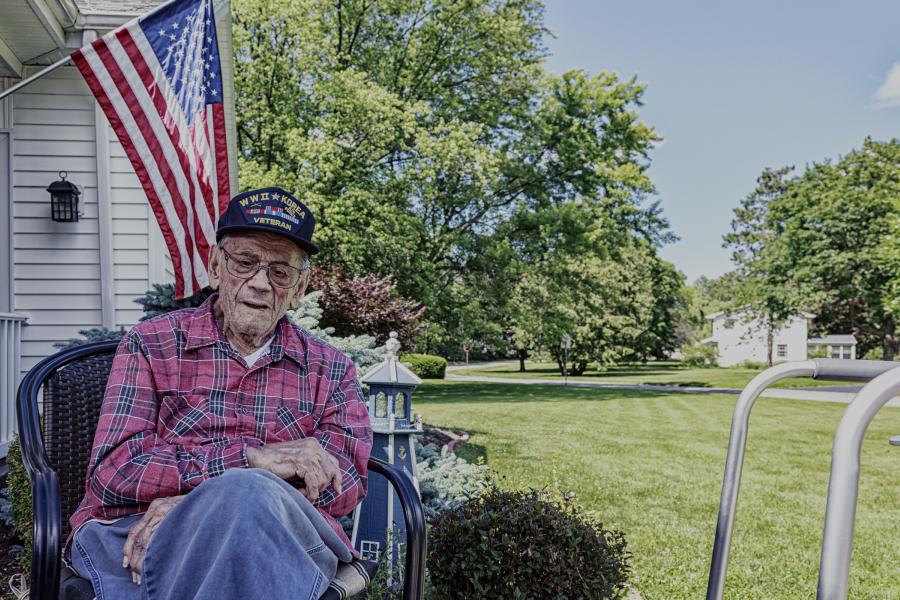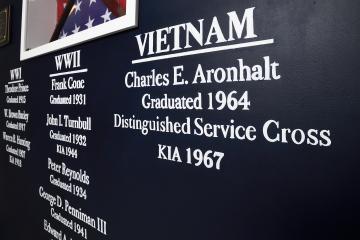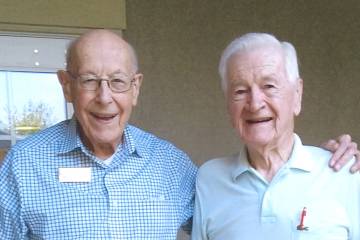As she prepared to observe her nursing students in an evaluation one recent morning, Johns Hopkins School of Nursing Associate Professor Rita D'Aoust noticed a participating patient wearing a Vietnam veteran's baseball cap. A longtime researcher of veteran health care, D'Aoust approached the man and struck up a conversation. She soon learned that he wasn't the only veteran serving as a patient for the student evaluation that day—there were two others, including a woman who, when approached, said she didn't consider herself to be a veteran, because she had never deployed or served in combat.
It's not uncommon to come across former service members who don't consider themselves to be veterans, says D'Aoust, who also holds a joint appointment in General Internal Medicine in the School of Medicine. Reluctance to identify as a veteran and misconceptions about what it means to be a veteran make caring for this vulnerable population so difficult.
For D'Aoust and her longtime research colleague Alicia Gill Rossiter, all interactions with patients in a health care setting should therefore start with a question: "Have you ever served, or has anyone in your family ever served?"
The answer to this simple question can unlock a wealth of insights into a person's potential exposures and health risks. It's also a central tenet of Caring for Veterans and Their Families: A Guide for Nurses and Healthcare Professionals, which D'Aoust and Rossiter edited.
"The military is a family business," says Rossiter, who is herself a veteran, as well as an associate professor, director of alumni and community relations, and chief officer of military and veteran affairs for the University of South Florida College of Nursing. "We know that upwards of 25% of new recruits have a parent who has served or is serving, and about 80% have some family member that has served. We also know that the number one predictor of whether a service member remains on active duty is the satisfaction of the military spouse and how the service member perceives their family being taken care of. So making sure that we are very cognizant of how we are supporting our military-connected children is vital to ensure that if in the event they do want to join the military, their physical and psychological needs have been met, and they're not disillusioned from their past experiences."
It is also central to the health and well-being of veterans that the care they receive is informed by their experiences in the military. The majority of health care provided for U.S. military veterans and their families takes place in the civilian sector, where providers might not be aware of military culture, practices, and exposures, D'Aoust says.
"You could be in the military, even in military health care, but that doesn't mean you understand veteran health or veteran health care," D'Aoust says. "You can work in the [U.S. Department of Veterans Affairs] and not understand the military's culture, just as you could be in the civilian sector or in policy and not know all the factors that affect veteran health care."
For more insights into the health care needs of veterans and their families, and for more takeaways from their book, the Hub reached out to D'Aoust and Rossiter.
While veterans are not a monolith, are there any characteristics of this population that set them apart in terms of their health care needs?
D'Aoust: I think it's important to understand the impact of military service on the physical and mental health of veterans. And you don't have to have been deployed or in combat—there are a unique set of factors that service members undergo when they serve our country.
Rossiter: We need to be very cognizant of not only the physical but psychological wounds of war as well as the exposures that accompany their service, even if they haven't gone to war or served in a combat or deployed setting. For health professionals, just because a veteran tells you they've never served in a combat zone doesn't mean that there aren't questions that you need to ask or be aware of—things like where they've served, what kind of service, what their jobs were that could have exposed them to either physical or psychological wounds.
We have a colleague who has PTSD, and it wasn't caused by being in a combat zone—he did a search and rescue after a plane crash that turned into a search and recovery. This led to him develop significant PTSD from this experience. So asking about a patient's service history and experiences—knowing when they served, what era, whether they were in Vietnam, World War II, Afghanistan, Iraq—it's very helpful to understand these things to determine their potential exposures and risks.
What led you to this line of research?
D'Aoust: So for me, I really became involved in veterans not just because my husband's a veteran, but because in practice, I work with the uninsured. And I was seeing among my patients transitory employments, binge drinking on the weekend, substance use, and other trends. So finally I said, tell me about yourself, and what I found was this commonality of prior service.
When Alicia and I were working together, we had developed a course on veteran health care, and we had RN to BSN students who worked in both the VA and the civilian sector. What we found in the course feedback is that just because you work in a VA health facility doesn't mean you understand veteran health issues or what the military culture is like. So there's a strong need for all providers to understand these exposures veterans have—things like binge drinking or substance use on the weekends where veterans might be trying to anesthetize some of their pain. Or occupational exposures—toxic contaminants in the Camp Lejeune drinking water or PFAS, the so-called forever chemicals in the flame retardants that were used on bases during exercises. Or the unique needs of women veterans, including military sexual trauma, or MST. In the civilian sector as well as the VA setting, providers and professionals need to understand the needs of veteran groups.
But it's also important to understand the needs of veteran families. Think about children who are uprooted every three years or families where a spouse or parent is deployed and can't be reached.
Rossiter: I was active-duty Army after I graduated from college. I deployed during the first Gulf War caring for wounded warriors in the deployed setting. When I transitioned off active duty I went into the Air Force Reserves for another 20 years before I retired. During my time in the reserves, I continued caring for wounded warriors from the wars in Iraq and Afghanistan once they came back to the United States. I'm a family nurse practitioner board certified in pediatrics, so then I moved into doing my reserved duty at a clinic at MacDill Air Force Base in Tampa, which is home to U.S. Central Command and U.S. Special Operations Command, so we had a lot of military-connected children, some of whose parents were deployed. And that's really kind of where my interest in military-connected children came about. And from there I started researching the impact of parental military service on the physical, psychological, and behavioral health of military-connected children.
What have been the key takeaways from your work and your book?
D'Aoust: Different perspectives might touch the elephant, but they don't see the whole elephant. You could be in the military, even in military health care, but that doesn't mean you understand veteran health or veteran health care. You can work in the VA and not understand the military's culture, just as you could be in the civilian sector or in policy and not know all the factors that affect veteran health care. So what we were hoping to do with this book is to really bring those perspectives together. We divided the book into four major areas—understanding the system, physical wounds, psychological wounds, and a special fourth section on veteran families and children, but also veteran end-of-life care.
Consider: Vietnam veterans, who right now are the greatest proportion of veterans, tend to be not only older but much more complex, especially with their psychological needs. So what we were trying to do in this book is to really educate health care professionals on who the veteran is, what are veteran-associated or service-connected disabilities, and what are the resources. And it's not just for nurses in health care, it's also for families and others. So they know how to help and where those resources are.
What are the areas of veteran health that need the most support?
D'Aoust: One of the major areas that we struggle with today is suicide rates. Veteran suicides are being underreported. According to a recent study by Operation Deep Dive, veterans take their own lives each year at a rate approximately 2.4 times greater than previously reported by the Department of Veterans Affairs. And again, it's the lack of recognition and inaccurate record-keeping that prevent us from counting these deaths accurately. And where the veterans are most vulnerable is often in the civilian sector, where health care providers are not aware of veterans' needs, or even that their patients are veterans.
Rossiter: Identifying who the veteran and military-connected patients are in our clinical practices is another area in need of attention. We always want to make sure we ask, "Have you ever served?" or "Do you have a parent who has served?" or "Do you have a spouse that has served?" Because, oftentimes, people don't really understand what that they're being asked, and sadly we see a lot of our veterans fall through the cracks—they don't know that they're eligible for services within the VA because they don't realize that their service qualifies them.
What can health care providers do better to support veterans and their families?
Rossiter: Educate yourself on the unique health care needs of veterans. The American Academy of Nursing Military and Veteran Health Expert Panel created a pocket card for health care providers that provides prompts for speaking with veterans and their families. It breaks everything down by service era—World War II, Vietnam, Desert Storm, Iraq and Afghanistan—and gives you questions to ask to determine potential risks for PTSD, sexual trauma, traumatic brain injuries. There's a whole host of questions on the first side, and the other side provides what to look for based on where you've served, as well as resources. And as an American Academy of Nursing Jonas Policy Scholar, I led the development of the I Serve 2 pocket card, and we have a colleague, Catherine Ling at Johns Hopkins, who is developing the Serving on the Home Front pocket card for spouses, partners, and caregivers. From a policy and advocacy perspective, these efforts are about looking at the entire military family and not siloing them. We have to be able to provide care for the entire family to ensure that their health needs are being met because we know when one serves, all serve.
What else should we keep in mind about the health of veterans and their families?
Rossiter: For 20 years, we were at war and veterans were on the forefront of a lot of national discussions. There was a push with policy to surround our veterans with support—remember the yellow ribbons saying "Support our troops" and the push to bring our veterans home? And now they're home and there's no war going on, I worry they're starting to fall through the cracks. So again, every patient should be asked a question, "Have you ever served" or "Do you have a family member who served?" And make sure that when you ask that question, you know what to do with the answer. This is where I believe our book can mitigate the gap in provider knowledge and comfort level in caring for veterans and their families.
D'Aoust: The other thing to point out is that the face of serving in a conflict has changed. If you look at the kinds of injuries from the Vietnam or even the Korean conflict, they're very different from some of the injuries veterans sustain today. But if you think about the war on terrorism and the modern weapons—people being killed by drones. Who do you think is operating that drone? Are they in fatigues out in the Middle East or are they sitting in a black box building, and then they go home and pick up their kid from soccer practice and supposedly life is OK? What are they carrying with them? So I think we have to start looking at some of those differences, and remember that when you serve, it doesn't end with your discharge paper. There's always an impact, and even sometimes on the family.
It's not just important to remember this on Veterans Day, and it's not just an issue for the VA to resolve, or the Department of Defense. It's actually on all of us. The price of our freedom is heavily fought, both during conflict and not in conflict, and these service members and their families are the ones who endure it.
Posted in Health, Voices+Opinion
Tagged health care, veterans











